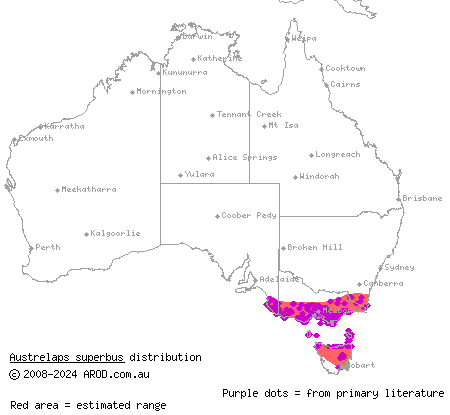Post by Ceratodromeus on Jan 6, 2016 0:21:58 GMT 5

Scientific classification
Kingdom: Animalia
Phylum: Chordata
Subphylum: Vertebrata
Class: Reptilia
Order: Squamata
Suborder: Serpentes
Family: Elapidae
Genus: Austrelaps
Species: A. superbus
Description
Despite the common name, the Australian lowland copperhead is not closely related to the American copperhead (Agkistrodon contortrix). Like its american namesake, though, it is a venomous species. This snake gets its common name from the copper-tone brown coloration, though depending on location this coloration can be more reddish or black. A red stripe can be found running horizontally throughout the snake's length. The species is sexually dimorphis, with males being larger then females; depending on locality males measure 75-80cm(2.4-2.6ft) in snout-vent vent length, while females measure 66-72cm(2.1-2.3ft) in snout-vent length. Large individuals can measure as much as 124cm(4.06ft) in snout-vent length{1}.

Geographic range and Habitat
This species can be found in the extreme South-east of Australia, where it can commonly be found near bodies of water where it spends most of its time foraging for food.
Dietary habits
The diet of the lowland copperhead consists primarily of anurans, lizards, and snakes. Species documented as part of the lowland copperhead's diet include Australian swamp frogs(Limnodystes), Bibron's toadlet(Pseudophryne bibronii), common froglet(Ranidella sigifera), Green and golden bell frog (Litoria Aurea), blue mountains tree frog(Litoria citropa), Lesueur's frog(Litoria leuseuri), maccoy's elf skink(A. Maccoyi), garden skink (Lampropholis delicata), common garden skink (L. guichenoti), Entrecasteaux's skink( leiolopisma entrecaseauxii) metallic cool skink(L. metallicum), South-western Cool-skink(L. trilineatum), blotched blue tongues (Tiliqua nigrolutea) and the mustard-bellied snake (Drysdaster rhodogaster). Instances of cannibalism have also been reported{1,2}.
Reproduction
These snakes are live bearing, with mating occurring in Australia's late spring(November), and after a gestation period of fourteen weeks, the young are born in the summer(February-March). Anywhere from 9-31young are born, depending on the size of the maternal female{3,4}.
References
{1}Shine, Richard. "Ecological ramifications of prey size: food habits and reproductive biology of Australian copperhead snakes (Austrelaps, Elapidae)." Journal of Herpetology (1987): 21-28.
{2} Fearn, S., J. Dowde, and D. F. Trembath. "Body size and trophic divergence of two large sympatric elapid snakes (Notechis scutatus and Austrelaps superbus)(Serpentes: Elapidae) in Tasmania." Australian Journal of Zoology 60.3 (2012): 159-165.
{3} Shine, Richard. "Reproduction in Australian elapid snakes I. Testicular cycles and mating seasons." Australian Journal of Zoology 25.4 (1977): 647-653.
{4}Shine, Richard. "Reproduction in Australian elapid snakes II. Female reproductive cycles." australian Journal of Zoology 25.4 (1977): 655-666.



